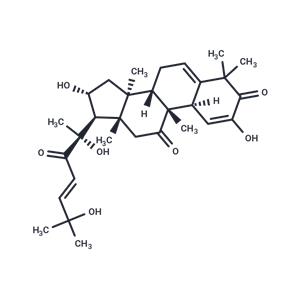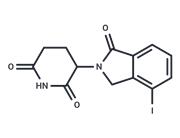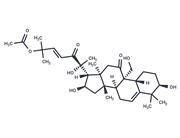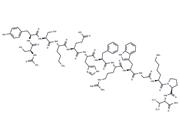| Name | Cucurbitacin I |
| Description | Cucurbitacin I (JSI-124), a natural compound, is a selective inhibitor of JAK2/STAT3 with anti-cancer activity. |
| Animal Research | BALB/c nude (nu/nu) female mice are used. U251 cells (5×10^6 cells in 50 μL of serum-free DMEM) are inoculated subcutaneously into the right flank of 5-week-old female mice after acclimatization for a week. Tumor growth is measured daily with calipers. When the tumors reach a mean volume of 90-120 mm3, animals are randomized into groups. In the first experiment, 16 mice are randomly assigned to Cucurbitacin I (1 mg/kg/day in 20% DMSO in PBS) or drug vehicle control (20% DMSO in PBS) and dosed intraperitoneally with 100 μL of vehicle or drug once daily for 18 days, whereas, in the second, 20 mice are assigned to four groups. Control animals receive 20% DMSO in PBS vehicle, whereas treated animals are injected with Cucurbitacin I (1 mg/kg/day) in 20% DMSO in PBS, CQ (25 mg/kg/day) in 20% DMSO in PBS, and Cucurbitacin I (1 mg/kg/day) plus CQ (25 mg/kg/day) in 20% DMSO in PBS and dosed intraperitoneally with 100 μL of vehicle or drug once daily for 15 days [4]. |
| In vitro | The anticancer activity of Cucurbitacin I is accomplished by downregulating p-STAT3 and MMP-9 expression [1]. Incubation of the Seax cell line with the Jak/Stat3 inhibitor Cucurbitacin I result in a time- and concentration-dependent decrease of P-Stat3 and Stat3. Incubation of freshly isolated Sz cells with 30 μM Cucurbitacin I for 6 hours induces apoptosis in the large majority (73-91%) of tumor cells [2]. PE-induced cell enlargement and upregulation of ANF and β-MHC are significantly suppressed by pretreatment of the cardiomyocytes with Cucurbitacin I. Cucurbitacin I also impaired connective tissue growth factor (CTGF) and MAPK signaling, pro-hypertrophic factors, as well as TGF-β/Smad signaling, the important contributing factors to fibrosis [3]. |
| In vivo | The differences in tumor volume between the Cucurbitacin I and control, combination and control, and combination and Cucurbitacin I arms are significant. Furthermore, combination-treated tumors exhibit a significantly lower average tumor weight at study termination than control. Moreover, there was no effect on the body weights of mice [4]. |
| Storage | store at low temperature,keep away from moisture | Powder: -20°C for 3 years | In solvent: -80°C for 1 year | Shipping with blue ice/Shipping at ambient temperature. |
| Solubility Information | DMSO : 95 mg/mL (184.59 mM), Sonication is recommended.
10% DMSO+40% PEG300+5% Tween 80+45% Saline : 2.5 mg/mL (4.86 mM), Sonication is recommended.
|
| Keywords | STAT3 | STAT | NSC521777 | NSC 521777 | JSI124 | JSI 124 | Janus kinase | JAK2 | JAK | Inhibitor | inhibit | Cucurbitacin I |
| Inhibitors Related | HODHBt | Ruxolitinib | Balsalazide disodium dihydrate | Nifuroxazide | Tofacitinib Citrate | Niclosamide | Ruxolitinib phosphate | Diosgenin | Niclosamide olamine | Artesunate | Upadacitinib | Alantolactone |
| Related Compound Libraries | Anti-Tumor Natural Product Library | Terpene Natural Product Library | Bioactive Compound Library | Membrane Protein-targeted Compound Library | Selected Plant-Sourced Compound Library | Kinase Inhibitor Library | Miao medicine Compound Library | Inhibitor Library | Natural Product Library for HTS | Bitter Compound library | Bioactive Compounds Library Max | Anti-Cancer Active Compound Library |

 United States
United States






